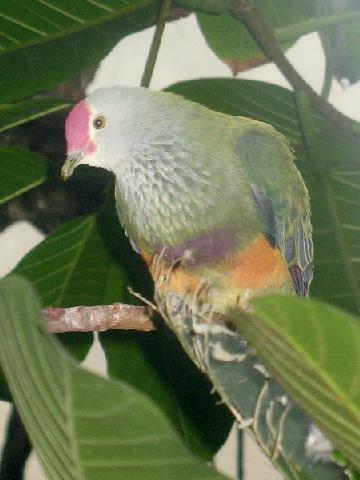|
| Query: small white | Result: 1024th of 2237 | |
Mariana Fruit-dove (Ptilinopus roseicapilla) - Wiki
| Subject: | Mariana Fruit-dove (Ptilinopus roseicapilla) - Wiki
| |

| Resolution: 360x480
File Size: 25536 Bytes
Upload Date: 2007:12:20 11:33:09
|
Mariana Fruit-dove
From Wikipedia, the free encyclopedia
Order: Columbiformes
Family: Columbidae
[Photo] Mariana Fruit-dove (Ptilinopus roseicapilla). Date May 5, 2007. Author http://commons.wikimedia.org/wiki/User:Stavenn | Permission is granted to copy, distribute and/or modify this document under the terms of the GNU Free Documentation License, Version 1.2 or any later version published by the Free Software Foundation; with no Invariant Sections, no Front-Cover Texts, and no Back-Cover Texts. A copy of the license is included in the section entitled "GNU Free Documentation License". |
The Mariana Fruit-dove, Ptilinopus roseicapilla also known locally as Mwee’mwe in the Carolinian language, Totot on Guam or Paluman Totut in Northern Mariana Islands is a small, up to 24cm long, green fruit dove native and endemic to Guam and the Northern Marianas Islands in the Pacific. It has a red forehead, greyish head, back and breast, and yellow belly patch and undertail coverts.
The female lays a single white egg. The chick and egg are tended to by both parents. Its diet consists mainly of fruits.
Culturally, the Mariana Fruit-dove is a very important symbol of the region. This species is the official bird of the Northern Marianas Islands. In 2005, the Mariana Fruit-dove was originally chosen as the official mascot of the 2006 Micronesian Games in Saipan. However, the official website for the games shows a tropicbird as the official symbol instead of the Mariana Fruit-dove.
The species faces extinction due to habitat loss throughout its range. A larger threat to the Mariana Fruit-dove has been the accidental introduction of the Brown tree snake to Guam during World War II. The snakes decimated the native bird populations of the island, which were unaccustomed to predators. They are extinct on Guam and the Mariana Fruit-dove is highly endangered on other islands in its range. The spread of the snakes to other Northern Marianas Islands could be devastating. Several zoos have started captive breeding programs. The St. Louis Zoo, in St. Louis, Missouri, has one of the most successful captive breeding programs. The program began in 1993.
Due to ongoing habitat loss, limited range, small population size and invasive alien species, the Mariana Fruit-dove is evaluated as Endangered on the IUCN Red List of Threatened Species.
http://en.wikipedia.org/wiki/Mariana_Fruit-dove
| The text in this page is based on the copyrighted Wikipedia article shown in above URL. It is used under the GNU Free Documentation License. You may redistribute it, verbatim or modified, providing that you comply with the terms of the GFDL. |
|
^o^
Animal Pictures Archive for smart phones
^o^
|
|